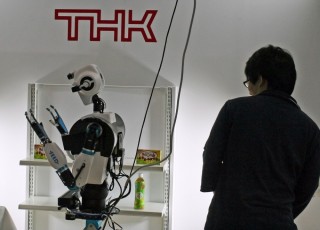Loading
Search
▼ Japan Races to Become The Robot Capital of The World
- Category:Other
Japan may have a long way to go before it can build a fully functional Gundam or Doraemon, but it’s getting closer to bringing sci-fi-style robotic helpers and protectors into our daily lives. Japan Robot Week, which took place at the Tokyo Big Sight convention center from Oct. 19 to 21, showcased the country’s premiere service robots. SoftBank, Hitachi, Tokyo’s Waseda University and more than 100 other organizations showcased their most recent robotic achievements at the event.
Japan Robot Week is part of the government’s 2015 plan to significantly increase growth in the robot industry by 2020 and position the nation as the world’s largest society supported by robotic technology. China has currently surpassed Japan in terms of the number of robots added to the workplace annually. In order to become the global robot leader, Japan must incorporate robotic technology into factories and households — robots need to become accessible to everyone in society.
At Kanagawa Prefecture’s Robot Innovation booth, the region showcased its many robotics businesses and initiatives, such as Robot Town Sagami, a special area where robotics research is subsidized. The 12 small cities that make up Sagami work with the government to relax regulations pertaining to robotic research, encouraging smaller companies to develop cutting edge technology.
Other booths focused on medical and nursing care, an increasingly important field for Japan and its aging population. Many companies presented robotic assistive devices and powered exoskeletons — the closest things we have to a real-life “Iron Man” suit.
One of the most notable assistive devices is Cyberdyne’s HAL or “Hybrid Assistive Limb,” which won the first Ministry of Health, Labour and Welfare’s Robot Award. Claiming to be “the world’s first cyborg-type robot,” HAL reads bioelectric signals sent to muscles that leak out to the skin. These signals are then used to enhance the user’s motions, giving the them heightened strength and stability when walking or performing laborious tasks.
Service robots have been successful in industrial and agricultural settings, but there is still plenty of room for them to assume customer-facing roles.
Softbank’s Pepper was one of the few communicative robots on display at Japan Robot Week. Its makers claim Pepper can not only read emotions but also have them itself, making it one of the world’s first communicative humanoid robots. Peppers were seen all over the convention hall, with some organizations combining the robot with their own programs.
Though it’s weaker at communicating, the humanoid robot at THK’s Seed Solution booth had the upper hand when it comes to physical performance. With Seed Solution’s hardware and Asratec’s operating system, THK’s humanoid is able to generate smooth gestures, greeting guests and demonstrating its ability to place objects — slow but steady —onto shelves.
With computing technology developing so rapidly, it isn’t hard to imagine communicative humanoid robots being put to work at hospitals and nursing homes in the near future. But whether Japan can become the world’s robot capital by 2020 is another question.
Japan Robot Week is part of the government’s 2015 plan to significantly increase growth in the robot industry by 2020 and position the nation as the world’s largest society supported by robotic technology. China has currently surpassed Japan in terms of the number of robots added to the workplace annually. In order to become the global robot leader, Japan must incorporate robotic technology into factories and households — robots need to become accessible to everyone in society.
At Kanagawa Prefecture’s Robot Innovation booth, the region showcased its many robotics businesses and initiatives, such as Robot Town Sagami, a special area where robotics research is subsidized. The 12 small cities that make up Sagami work with the government to relax regulations pertaining to robotic research, encouraging smaller companies to develop cutting edge technology.
Other booths focused on medical and nursing care, an increasingly important field for Japan and its aging population. Many companies presented robotic assistive devices and powered exoskeletons — the closest things we have to a real-life “Iron Man” suit.
One of the most notable assistive devices is Cyberdyne’s HAL or “Hybrid Assistive Limb,” which won the first Ministry of Health, Labour and Welfare’s Robot Award. Claiming to be “the world’s first cyborg-type robot,” HAL reads bioelectric signals sent to muscles that leak out to the skin. These signals are then used to enhance the user’s motions, giving the them heightened strength and stability when walking or performing laborious tasks.
Service robots have been successful in industrial and agricultural settings, but there is still plenty of room for them to assume customer-facing roles.
Softbank’s Pepper was one of the few communicative robots on display at Japan Robot Week. Its makers claim Pepper can not only read emotions but also have them itself, making it one of the world’s first communicative humanoid robots. Peppers were seen all over the convention hall, with some organizations combining the robot with their own programs.
Though it’s weaker at communicating, the humanoid robot at THK’s Seed Solution booth had the upper hand when it comes to physical performance. With Seed Solution’s hardware and Asratec’s operating system, THK’s humanoid is able to generate smooth gestures, greeting guests and demonstrating its ability to place objects — slow but steady —onto shelves.
With computing technology developing so rapidly, it isn’t hard to imagine communicative humanoid robots being put to work at hospitals and nursing homes in the near future. But whether Japan can become the world’s robot capital by 2020 is another question.
- November 15, 2016
- Comment (0)
- Trackback(0)


